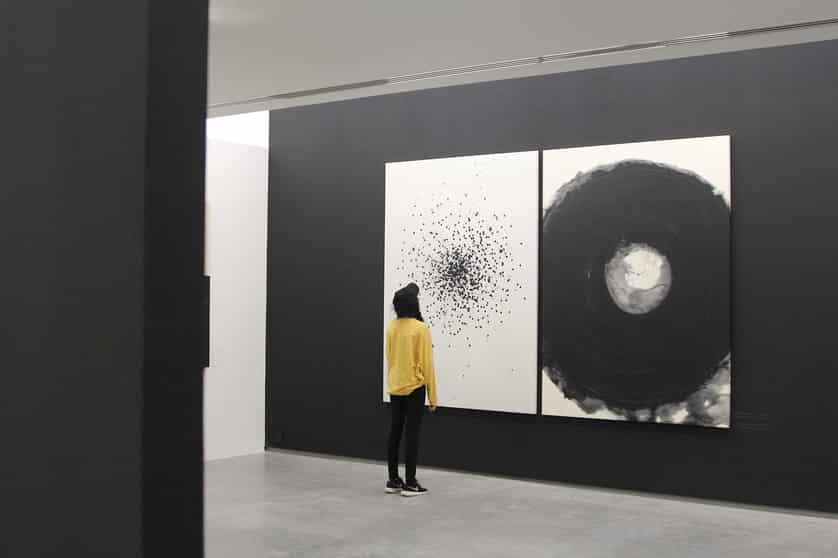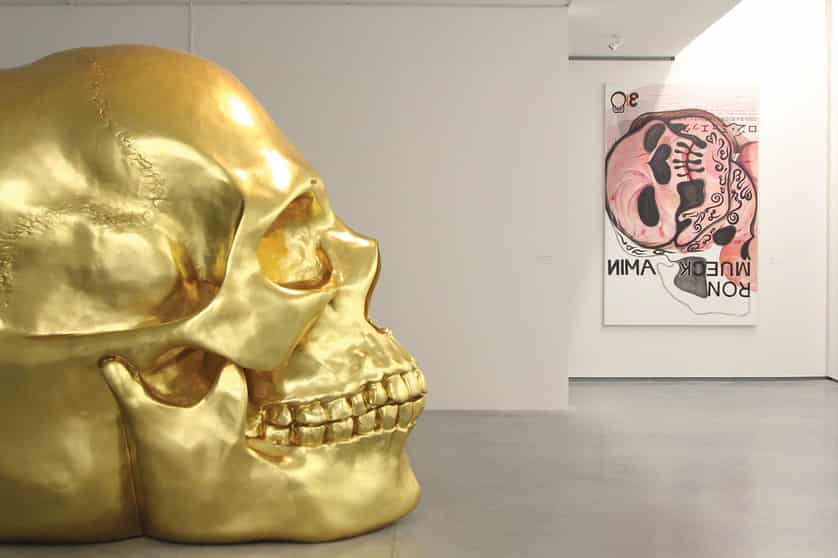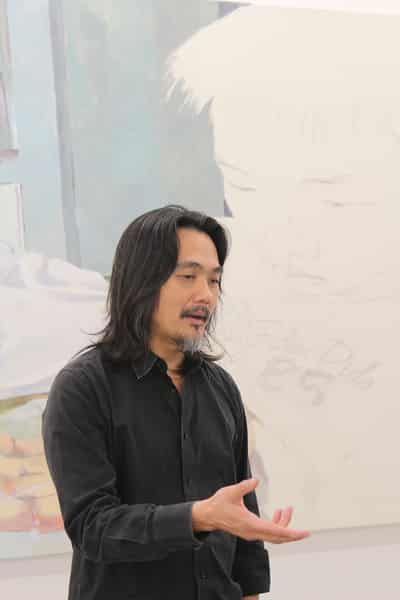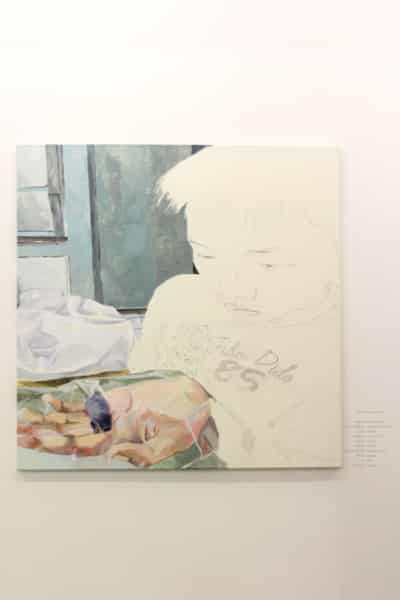When the MAIIAM Contemporary Art Museum opened its glittery doors earlier this year, its walls covered with artworks, and its vast exhibition spaces featuring sculptures, multimedia exhibits and installations by some of the most significant Thai artists of our generation, it not only provided our city with its first permanent contemporary art space, introducing the Chiang Mai public to works of art previously only seen by those privileged enough to travel further afield, but also gave a vital nod of respect and encouragement to Chiang Mai’s vast, diverse and prolific art scene.

There are some giants in the Thai, and to some extent international, art world who call Chiang Mai home. Amongst them is Kamin Lertprasertchai known for his technical mastery and envelope-pushingly prolific career. MAIIAM houses a permanent collection of art from dozens of artists, but also has quarterly exhibitions, currently showcasing ‘The Timeless Present Moment’ exhibition. This exhibition, six years in the making, showcases an extraordinary body of work from sculpture to installation, film to paint.
Kamin has called Chiang Mai home for decades, though was born in Lopburi before moving to Bangkok to study fine arts at Silpakorn University, where, in 1987 he won the Young Artist of the Year award, the first in a lifetime of recognitions and accolades.
“I was always curious and even as a child as young as seven or eight I would ask questions or have thoughts which went against the cultural grain,” said Kamin as we sat faced on all sides by his large canvases, some oddly bare and ostensibly unfinished. “I would ask why old people bothered to live, or opine that I would like to become a career monk so I didn’t have to earn a living. These questions whirled around in my head. Because I went to a Christian school but am a Buddhist, questions surrounding philosophy and religion — not its structures or rituals, but its nature — have always been fascinating to me.”

Young Kamin had great ambitions, dreaming of leaving a legacy for future generations. He, like many budding artists, used art to satisfy his questions in life — the whys, hows and what fors. “I used to splatter paint on canvasses and scribble furious lines on my artworks to directly express my emotions and thoughts. I didn’t know how to resolve issues, I simply expressed them.”
Kamin was born with talent, but his career has developed his techniques and talent into a way of life; his art a reflection, a medium as well as a tool to shape his thoughts.
“Drawing, painting and sculpting came naturally to me, even recently when I asked one of my students to teach me how to make a film, technically it was easy. When I went to live in New York for five years after college, I yearned to be accepted into the glamorous art world there, but I found the art world very Euro-centric, with its own set of rules in a game I soon lost interest in playing. By that time I was already meditating and taking a personal journey with dharma, a journey of little interest to the accepted norm viewed from a western perspective. I realised by that time that art in itself made me happy and decided to return to Thailand to continue what I called my life-specific.”
Kamin says that his journey truly began after his return to Thailand, and soon after-move to Chiang Mai in 1996. Realising that, like meditation and his voracious search for knowledge — Kamin is a prolific reader, consuming books on a wide number of subjects including philosophy, poetry, science, poetry and technology — art was to become his personal journey. He began to use art as therapy, looking inwards to heal and resolve — his beliefs, his needs and his existence. Once his internal dialogue was resolved, he began to use his art to commentate on society, religion and politics.
“My journey came in three steps; the first was as art therapy, looking inwards, you could say. Then my years of social commentary and critique had me looking outwards. Now, I am at the point where I am seeking truth in nature, religion and philosophy, looking at the laws within, not ones influenced by man. I am now free to create art without internal or external pressure or influence.”
Kamin is an artist, a philosopher but also a great teacher and collaborator. In 1998 he founded The Land Project here in Chiang Mai, creating a collaborative space in a rice field for local and international artists. There were quirky buildings, odd structures and sculptures, artisanal workshops and all manner of artists creating and expressing. His 31st Century Museum of Contemporary Spirit is a conceptual project and art gallery, of seven shipping containers on Soi Wat Umong which also saw daily visitors; art enthusiasts, students and artists.
“I need to share and pass on whatever I have that others may find useful, I want to offer opportunities to other artist. Being selfless is part of the Buddhist philosophy.”
“I meditate every day and I stop the moment I get an idea, and that is when I start working. Many of my works seen here I may have conceptualised or drawn, but are also collaborations with many of my students who helped to paint, film and sculpt.”
The first time visitor (this writer included) may miss the eerily realistic model of Kamin’s assistance, Ting Chu, bent over her hands cupped around a baby mouse, which stands in the courtyard leading into the exhibition space. This sculpture is echoed in a painting in the exhibition depicting a small boy, hand gloved in plastic, holding yet another baby mouse, telling the true stories of the subjects, both of whom saved a baby mouse from a sure death due to their compassion, generating multiple questions Kamin’s art goes some way in answering. Further inside the main exhibition hall lies 365 ceramic bowls, handcrafted by Kamin over two years, with many depicting words drawn from his daily meditations. This installation is punctuated by a similarly uncanny model of the artist himself at one end, nude and meditating, depicting its presence as both subject and object of Kamin’s journey.

The exhibition rooms each contain a narrative of Kamin’s internal journey expressed through his art, whether it’s the room featuring a huge gilded skull, with a vaginaesque opening in the back where one can enter to meditate on life and death; the abstract paintings of atoms and the universe, sizes reversed to depict the ever-changing movements of time, space and object; or the paintings with holes in them depicting the invisible nature of emptiness; for without environmental context, time, space and dimension cannot be seen.
As Kamin wraps up the interview, ready to greet a group of visiting art students, he points to a painting nearby. It features a photograph of two smiling girls, surrounded by what appears to be hastily sketched people, only partially filled in with paint.
Alt: “maiiam05”
“I was in Chicago one day and walked past a café where these two girls were waving this sign up at passersby, it said, ‘Have a great night!’. Curious I walked in to ask why they were doing this to strangers and they told me that they wanted to share their happiness and I thought to myself, ‘How altruistic and lovely’. I asked to take a photo of them and I sketched out this canvas and asked one of my students to paint it in. After starting the painting, he left to travel and didn’t return for a long time. One day I looked at it and realised that that painting was complete. It is a painting about the past, if I finished this painting, for example, like completing the building of a house, it will become old immediately, the future is also shown in this painting, because it is incomplete, like the continuing process to the audience when they see this painting and wonder when and how it will look, but also always about the present because it will never be finished.”

It is extraordinary to think that Chiang Mai is now home to such artworks, housed in a museum which already contains some of the best pieces of contemporary art to have come out of Thailand in the past few decades.
“MAIIAM is the only place in Thailand that offers a complete space at this level. Its owner is passionate in his support of the arts, the space is of world standard, the art finely curated and displayed and with a true understanding of contemporary art.”
122 Moo 7, Tonpao, Sankampheang
Open: Everyday except Tuesdays
Open hours: 10am – 6pm
Admission fee: adults 150 THB, students/seniors 100 THB, under 12 yrs free.
Tel: 052 081737
